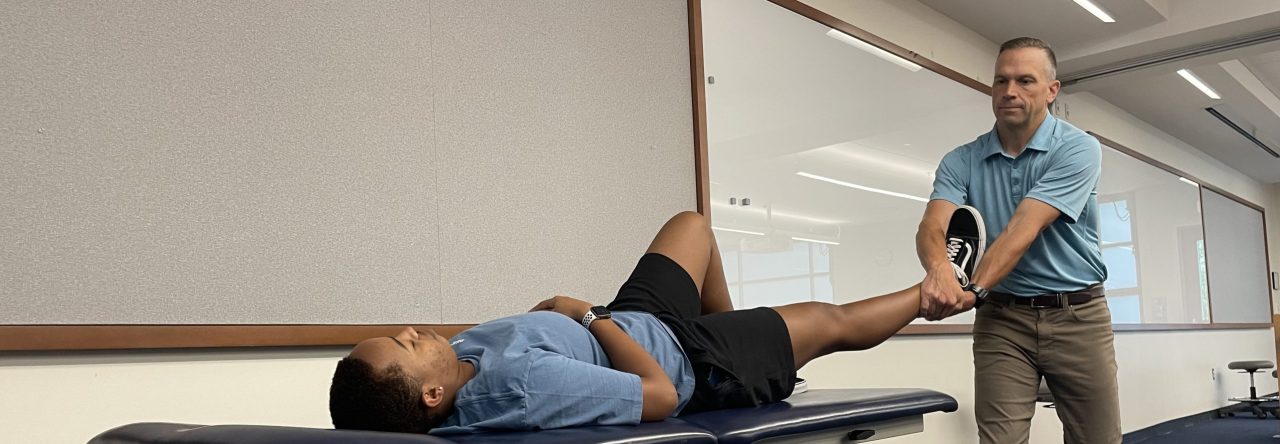Author Names
Rodríguez-Pastor, J., Caro-Puértolasa, B., Caña-Pino, A., Sánchez-Preciado, A., Garrido-Ardila, E., Apolo-Arenas, M.
Reviewer Name
Daniel Vay, SPT, ATC, LAT
Reviewer Affiliation(s)
Duke University Doctorate of Physical Therapy Division
Paper Abstract
BACKGROUND: One of the main problems faced by physiotherapists in primary care is low back pain with or without radiation to lower limbs. There are many different treatment approaches for the management of low back pain. Despite the large amount of published studies, the evidence remains contradictory. OBJECTIVE: To evaluate the influence of the osteopathic manipulation of the sacroiliac joint on low back pain with or without radiation to lower limbs. METHOD: Single-blind randomized clinical controlled trial. Participants with low back pain with or without lower limb radiation were randomized to osteopathic manipulation of the sacroiliac joint group (intervention, 6 sessions) or to an electrotherapy group (control, 15 sessions) for 3 weeks. Measures were taken at baseline (week 0) and post-intervention (week 4). The primary outcome measures were pain (Visual Analogue Scale), functional disability (Oswestry disability index and Roland Morris questionnaire). The secondary outcome measure was pain threshold at muscular tender points in the quadratus lumborum, pyramidal, mayor gluteus, and hamstrings. RESULTS: In all, 37 participants completed the study. The results of the intragroup comparisons showed statistically significant improvements in both groups in the visual analogue scale (Osteopathic manipulation group, P = 0.000; Electrotherapy group, P = 0.005) and Oswestry disability index (Osteopathic manipulation group, P = 0.000; Electrotherapy group- P = 0.026) but not in the Roland Morris questionnaire (P = 0.121), which only improved in the intervention group (P = 0.01). The osteopathic manipulation was much more effective than electrotherapy improving to pain and functional disability. CONCLUSION: Osteopathic manipulation of the sacroiliac joint improves pain and disability in patients with sacroiliac dysfunction after three weeks of treatment.
NIH Risk of Bias Tool
Quality Assessment of Controlled Intervention Studies
- Was the study described as randomized, a randomized trial, a randomized clinical trial, or an RCT?
- Yes
- Was the method of randomization adequate (i.e., use of randomly generated assignment)?
- Yes
- Was the treatment allocation concealed (so that assignments could not be predicted)?
- Yes
- Were study participants and providers blinded to treatment group assignment?
- No
- Were the people assessing the outcomes blinded to the participants’ group assignments?
- No
- Were the groups similar at baseline on important characteristics that could affect outcomes (e.g., demographics, risk factors, co-morbid conditions)?
- No
- Was the overall drop-out rate from the study at endpoint 20% or lower of the number allocated to treatment?
- Yes
- Was the differential drop-out rate (between treatment groups) at endpoint 15 percentage points or lower?
- Yes
- Was there high adherence to the intervention protocols for each treatment group?
- Yes
- Were other interventions avoided or similar in the groups (e.g., similar background treatments)?
- No
- Were outcomes assessed using valid and reliable measures, implemented consistently across all study participants?
- Yes
- Did the authors report that the sample size was sufficiently large to be able to detect a difference in the main outcome between groups with at least 80% power?
- Cannot Determine, Not Reported, or Not Applicable
- Were outcomes reported or subgroups analyzed prespecified (i.e., identified before analyses were conducted)?
- Yes
- Were all randomized participants analyzed in the group to which they were originally assigned, i.e., did they use an intention-to-treat analysis?
- Yes
Key Finding #1
Both osteopathic manipulation and electrotherapy treatments were effective in reducing pain and disability in patients through the Oswestry Disability Index.
Key Finding #2
Intergroup analysis revealed that osteopathic manipulation was more effective for pain and functional disability than electrotherapy treatment.
Key Finding #3
Osteopathic manipulation required less treatment sessions to achieve improvements in pain (6 sessions maximum) as compared to the electrotherapy group (15 sessions).
Key Finding #4
Electrotherapy only proved to be effective on the Oswestry disability index, when patients are more affected with greater impairment and functional disability.
Please provide your summary of the paper
This study looked at the effectiveness of osteopathic manipulations of the SIJ vs electrotherapy on the ratings of pain and functional disability. The primary outcome measures were the Visual Analogue scale (VAS), Oswestry Disability Index, and the Roland Morris Questionnaire. A total of 37 patients out of 150 were included after the exclusion criteria was put in place. The Intervention group (osteopathic manipulation) completed a total of 6 sessions over the span of 3 weeks, 2 sessions per week. The control group (electrotherapy) completed a total of 15 sessions over 3 weeks, 5 sessions per week. Both treatments were performed by a qualified physiotherapist member of the Spanish Chartered Society of Physiotherapists, trained in joint osteopathic manipulation and electrotherapy. The results found that both treatments were effective in reducing pain and disability through the Oswestry Disability Index. Although, through intergroup analysis, the osteopathic manipulation intervention group revealed to be the more effective method.
Please provide your clinical interpretation of this paper. Include how this study may impact clinical practice and how the results can be implemented.
The direct clinical impacts from this paper include the potential benefits for implementing osteopathic manipulation and electrotherapy for patients with low back pain with or without radiation to the lower limbs. Given the results of the study, the effectiveness of osteopathic manipulation in reducing pain and functional disability over a short duration of treatment sessions shows important consideration for clinicians when comparing the multiple methods of treatment. Further research is needed to investigate long term effects of osteopathic manipulation and further studies with increases in sample size and more specific inclusion criteria can help improve clinical decision making regarding these methods.
